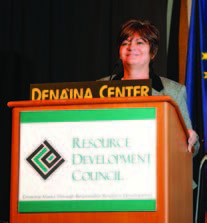Alaska fisheries strong, yet face challenges
By Kati Capozzi
At this year’s Alaska Resources Conference, RDC board member and At-Sea Processors Association Executive Director Stephanie Madsen provided updates on the status of Alaska’s fisheries and seafood industry. Madsen explained that fisheries management falls under a number of different umbrellas and due to the literal ‘moving target’ nature of this resource extraction industry, the rules, regulations, and allocations are ever-changing.
Madsen highlighted that for the first time an Alaska maritime workforce development plan is in place. The plan, released in May, lays out three main goals: develop a responsive workforce that enables the maritime sector to remain a substantial contributor to the state, guiding Alaska’s workforce to discover and prepare for the wide range of employment opportunities in the maritime sector, and increase the number of Alaskans working in skilled maritime occupations. Madsen added that Alaska is experiencing an “aging fleet” in the average age of workers in the industry and is hopeful the new workforce development plan will usher in a new generation of a skilled workforce.
“In the fishing industry, we consider species as a portfolio, some go up, some go down, so you really hope that overall things remain stable…the indications are that the stocks both in the Bering Sea and the Gulf of Alaska are strong,” Madsen explained. The healthy stocks in Alaska waters keep the state’s ports busy as well. Dutch Harbor, Akutan, and Kodiak ranked first, second, and third respectively nationwide for seafood landings in 2013.
Although the fisheries remain strong overall, there are a number of challenges facing the industry. Madsen said the Endangered Species Act continues to be a tool used by eNGOs to shut down entire geographical areas to fishing and is most often time consuming and extremely costly to combat. Additionally, the call for marine protected areas continues to be a hot button issue. “Generally, the seafood industry is not supportive of a blanket marine protected area network. We continue to have to battle those NGOs that view Alaska and Alaska fisheries as one of the last areas they can raise funds.”
Sustainability and what that word means to different groups of people worldwide continues to be a topic that remains front and center. Madsen noted sustainability is something that is written into Alaska’s constitution and the conservative management approach is something the industry is proud of. “Science is on our side and we have a strong future,” Madsen concluded.

Stephanie Madsen
Return to newsletter headlines